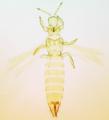Frankliniella williamsi
Recognition data
Distinguishing features
Both sexes fully winged. Body and legs yellow, distal antennal segments light brown; fore wing pale. Head wider than long; three pairs of ocellar setae present, pair III longer than margin of ocellar triangle, arising just within lateral margins; postocular setae pair I present, pair IV as long as distance between hind ocelli. Antennae 8-segmented; III–IV with sensorium forked; segment VIII twice as long as VII. Pronotum with 5 pairs of major setae; anteromarginal setae almost as long as anteroangulars; one pair of minor setae present medially between posteromarginal submedian setae. Metanotum with 2 pairs of setae at anterior margin; campaniform sensilla present. Forewing with 2 complete rows of veinal setae. Abdominal tergites V–VIII with paired ctenidia, anterolateral to spiracle on VIII; posteromarginal comb on VIII with long, regular, microtrichia. Sternites III–VII without discal setae, but sternite II usually with one or two long discal setae medially.
Male smaller than female; tergite VIII with complete comb; sternite II with one or two discal setae medially, III–VII with small oval pore plate, sternite VII with toothed craspedum on posterior margin.
Related and similar species
F. williamsi is similar in color and structure to F. gossypiana, but has a broader head, and the setae on the ninth abdominal tergite are longer (Mound & Marullo, 1996). Keys to 74 species of Frankliniella recorded from Central America and the Carribean were provided by Mound & Marullo (1996), and to 40 species from Brazil by Cavalleri & Mound (2012).
Taxonomic data
Current valid name
Frankliniella williamsi Hood
Original name and synonyms
- Frankliniella williamsi Hood, 1915: 19
- Frankliniella flavens Moulton, 1928: 108
- Frankliniella spinosa Moulton, 1936: 61
Family placement
Thripidae, Thripinae
Common names
Corn thrips
Biological data
Life history
Breeding on leaves and in leaf axils.
Host plants
Zea mays, but probably also other Poaceae including Saccharum.
Tospoviruses vectored
None
Crop damage
Feeding on young leaves results in streaks on the leaves of Zea mays.
Distribution data
Area of origin
Probably Central America.
Distribution
Widespread in tropical and subtropical countries around the world. In eastern USA the species is found from Florida to New York, but in the west it is recorded only from California and Texas.





